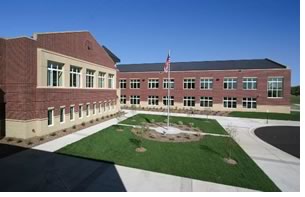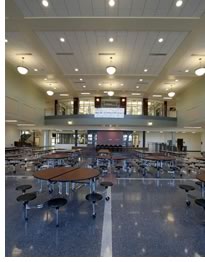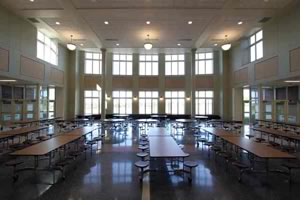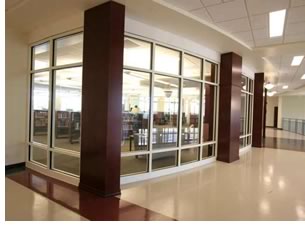

4/2006
KKE Architects melds tradition and high-performance

by Tracy Ostroff
 The high-performance prototype design for Hassan Elementary School,
Rogers, Minn., is the latest addition to the Elk River School District’s
growing portfolio of sustainable facilities. The hallmark of these buildings,
KKE Architects Inc. say, is the way they “incorporate sustainable
goals with the traditional, academic aesthetics.” Designed to meet
the U.S. Green Building Council’s (USGBC) certification criteria,
the $18-million building would use 50 percent less energy than a Minnesota
code-based building, according to an independent energy consultant.
The high-performance prototype design for Hassan Elementary School,
Rogers, Minn., is the latest addition to the Elk River School District’s
growing portfolio of sustainable facilities. The hallmark of these buildings,
KKE Architects Inc. say, is the way they “incorporate sustainable
goals with the traditional, academic aesthetics.” Designed to meet
the U.S. Green Building Council’s (USGBC) certification criteria,
the $18-million building would use 50 percent less energy than a Minnesota
code-based building, according to an independent energy consultant.
 The
99,400-square-foot-facility opened in August 2005. The building, which
sits on 24 acres, provides 133 square feet per student, accommodating
up to 750 students. “The City of Rogers was seeking a more traditional-looking
school building,” says Lee Meyer, AIA, KKE principal. The K–5 elementary
school’s main entry is an open court embraced by classroom wings
and lighted by the morning sun. Students arriving by bus enter into the
central commons through the exterior plaza, which serves as a gathering
area before and after school. As students and visitors arrive, they are
welcomed by the adjacent administration area, which is positioned for
an easily supervised, secure environment. Classrooms grouped along east-west
corridors offer optimal daylight from both north and south. Bell towers
and sloped roofs complete the campus feel.
The
99,400-square-foot-facility opened in August 2005. The building, which
sits on 24 acres, provides 133 square feet per student, accommodating
up to 750 students. “The City of Rogers was seeking a more traditional-looking
school building,” says Lee Meyer, AIA, KKE principal. The K–5 elementary
school’s main entry is an open court embraced by classroom wings
and lighted by the morning sun. Students arriving by bus enter into the
central commons through the exterior plaza, which serves as a gathering
area before and after school. As students and visitors arrive, they are
welcomed by the adjacent administration area, which is positioned for
an easily supervised, secure environment. Classrooms grouped along east-west
corridors offer optimal daylight from both north and south. Bell towers
and sloped roofs complete the campus feel.
 The media center, visible from both the student entry and commons, forms
the academic heart of the school. Its central location on the second
floor is accessible to all grade levels via a grand staircase and elevator.
Art, science, and music classrooms are clustered for easy school and
community use. Physical education and multipurpose rooms situated at
the south end of the corridor provide convenient community access.
The media center, visible from both the student entry and commons, forms
the academic heart of the school. Its central location on the second
floor is accessible to all grade levels via a grand staircase and elevator.
Art, science, and music classrooms are clustered for easy school and
community use. Physical education and multipurpose rooms situated at
the south end of the corridor provide convenient community access.
 Sustainable meets traditional
Sustainable meets traditional
Meyer explains that the sustainable nature of the school had its beginnings
six years ago when the school district received a state grant to study
sustainability and energy efficiency in schools. The architects, already
working with the district on other projects, joined school officials
on trips to Germany and Switzerland to study best practices. What they
discovered, Meyer says, is that they seemed to be designing buildings
that included LEED™ requirements, including large percentage of window-to-floor
area, shallow rooms so natural light could infuse far into the space,
and north to south orientations.
 For Hassan, the architects employed an efficient two-story design to
reduce the schools’ footprint. KKE also chose a traditional peaked
roof to suit the Rogers neighborhood and evoke a more home-like feel.
Other high-performance systems include dimming T5 lights, desiccant energy
recovery, high-efficiency boilers, and variable-air-volume systems.
For Hassan, the architects employed an efficient two-story design to
reduce the schools’ footprint. KKE also chose a traditional peaked
roof to suit the Rogers neighborhood and evoke a more home-like feel.
Other high-performance systems include dimming T5 lights, desiccant energy
recovery, high-efficiency boilers, and variable-air-volume systems.
In addition to savings from the energy-efficient technologies, the school district is seeing more green with rebates from Xcel Energy and CenterPoint Energy, the local utility companies. The Elk River Star News reports that rebates for Hassan Elementary totaled about $127,000. “It emphasizes we’re doing what I think people want us to do,” Ron Bratlie, the district’s director of special projects told the paper. KKE’s other two schools, Westwood Elementary and Rogers High School, also took advantage of the rebate program. Julia Gauthier, a product portfolio manager, explained in the article that Xcel had distributed rebates in the state ranging from $12,000 to $204,000. “We pay a rebate based on how much better (schools) do than minimum code requirements,” Gauthier says in the January 17 article.
Copyright 2006 The American Institute of Architects.
All rights reserved. Home Page ![]()
![]()
KKE Architects Inc. was recognized as Learning by Design “Lesson in Excellence” by the National School Boards Association and American School Boards Journal.
KKE’s design team included Mohammed Lawal, AIA; Jennifer Anderson-Tuttle; Juan Carlos Franchevich; Gustavo Ibarra; Fred Kirschman; Lee Meyer, AIA; Jeff Schauer, CCCA; and Stacy Sprute.
![]()